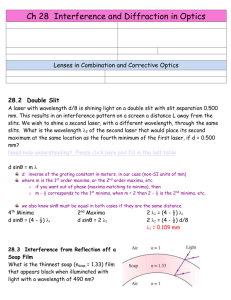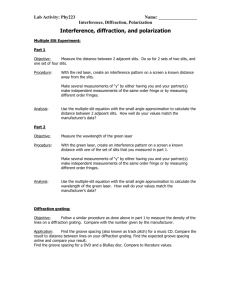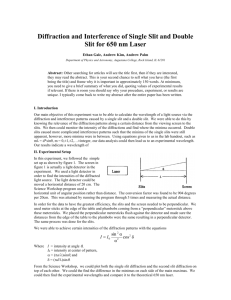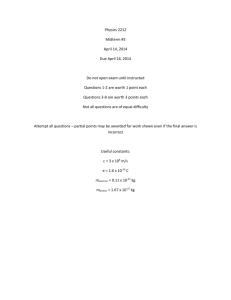Physics 228 Today: Diffraction, diffraction grating
advertisement
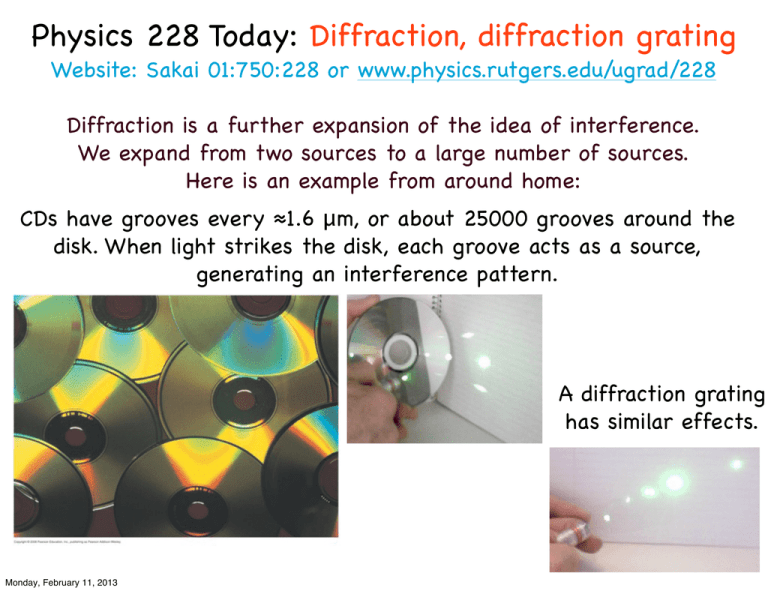
Physics 228 Today: Diffraction, diffraction grating Website: Sakai 01:750:228 or www.physics.rutgers.edu/ugrad/228 Diffraction is a further expansion of the idea of interference. We expand from two sources to a large number of sources. Here is an example from around home: CDs have grooves every ≈1.6 μm, or about 25000 grooves around the disk. When light strikes the disk, each groove acts as a source, generating an interference pattern. A diffraction grating has similar effects. Monday, February 11, 2013 Are Shadows Infinitely Sharp? IClicker Can shadows be infinitely sharp? a) Always! b) Yes - for a point source and sharp edge! c) Yes - for an edge. But not for a slit. d) Never - the world just doesn’t work that way. e) No - aren’t we studying diffraction today? Monday, February 11, 2013 Are Shadows Infinitely Sharp? No. Many examples: PhET demo, real physical in-class demo With a thin slit, you can see the light expand to both sides and form light and dark bands. Monday, February 11, 2013 Why Does Light “Expand” Past the Edges You Expect from Geometrical Optics? Huygen’s Principle Introduced back in chapter 33, but we did not cover it then. Each point on the wave front can be viewed as a source for spherical waves propagating out from that point. The wave front is the envelope of all the secondary waves. The sum of all these wavefronts will bend around corners, as compared to straight geometrical optics. Monday, February 11, 2013 Why Does Light “Expand” Past the Edges You Expect from Geometrical Optics? Huygen’s Principle Introduced back in chapter 33, but we did not cover it then. Each point on the wave front can be viewed as a source for spherical waves propagating out from that point. The wave front is the envelope of all the secondary waves. The sum of all these wavefronts will bend around corners, as compared to Diffraction = interference with many sources, straight geometrical optics. not just a couple Monday, February 11, 2013 Near-field vs far-field There are two situations we can consider, one where the image is close to the slit, the other where the image is far from the slit. We will stick to the 2nd, simpler, Fraunhofer, case. Here we are far enough away that the rays that come to a point in the image can be treated as going out essentially parallel from the source, the slit. Monday, February 11, 2013 Destructive interference An example of a simple case: divide the slit into two halves. Require the top point of each to interfere destructively. Require the middle point of each to interfere destructively. Etc., etc. The destructive interference is when the path length difference is λ/2. Condition for this destructive interference: λ/2 = (a/2)sinθ ➭ λ = a sinθ Monday, February 11, 2013 Where the Minima Are Monday, February 11, 2013 How do we get all the minima and maxima? Divide the slit into 2m sections. Require section i to interfere destructively with section i+1. The condition for destructive interference now is: λ/2 = (a/2m)sinθ ➭ λ = (a/m) sinθ sinθ = mλ/a The height of a dark band a distance x away is y = xtanθ ≈ mxλ/a Even More Minima? Isn’t there a second set of minima, with 3λ/2, 5λ2, ... path length differences for the slit in 2 a/2-wide halves? IClicker 2 a) No! You only get interference for path length differences of λ/2. b) Yes - there are minima not included in the formula sinθ = mλ/a. c) No - those minima are already included in the formula. d) No - each way you divide the slit only leads to one set of minima. You can do it one way or the other but not both. e) Yes - but the maxima are not so bright, so you do not really see them. Monday, February 11, 2013 Standard Numerical Problem sinθ = mλ/a or y = mRλ/a Give you 4 variables, ask for the 5th. A diffraction pattern with 500 nm light has bright bands separated by 1 mm a distance 5 m from the slit. What is the width of the slit? a = Rλ/Δy = (5)(500e-9)/(1e-3) = 25 μm. Monday, February 11, 2013 Intensity There is a very bright central peak surrounded by much dimmer side peaks. Why is this? Monday, February 11, 2013 One slit vs two slit Today: one slit, width a, has minima at: sinθ = mλ/a m = ±1, ±2, ... Maxima at m=0 and m half-integral. Last Monday: two slits, separation d, have maxima at: sinθ = mλ/d m = 0, ±1, ±2, ... Minima at m half-integral. Two slits are actually composed of two single slits with separation greater than their width. The intensity patterns of the two will combine / convolute for the total intensity pattern. Since d > a, the maxima and minima of the two-slit pattern will vary more quickly with angle than the pattern from the width of the slits. We will return to the intensity Thursday. Monday, February 11, 2013 Diffraction grating In a diffraction grating, we go from 2 slits to many slits. Diffraction gratings are usually labelled by the number of slits per unit length. It does not matter whether there are multiple slits with light from the left, or multiple grooves with light from the right. The path length difference between adjacent slits is: dsinθ There will be constructive interference between ALL slits when there is constructive interference between adjacent slits: mλ = dsinθ so sinθ = mλ/d This is the same algebra as for two-slit interference. With the larger number of slits, the pattern gets sharper. Let's see a demo. Monday, February 11, 2013 Reflection grating Diffraction gratings allow you to nicely separate the colors of the incoming light. Monday, February 11, 2013 Diffraction Grating I am going to change to a diffraction grating with more lines per inch. What happens to the diffraction pattern? IClicker 3 a) The spots move out. b) The spots move in. c) The spots stay in the same place, but get brighter. d) The spots stay in the same place, but get dimmer. e) This iClicker is too easy. Now: what happens when I go to a different wavelength laser? Monday, February 11, 2013

